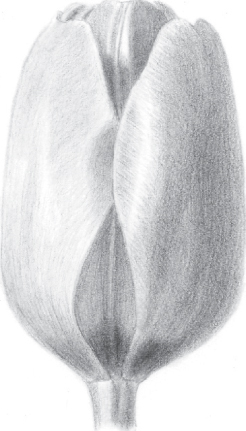The best inspiration often comes from nature, and I’m particularly drawn to my garden in full bloom! I often make quick sketches outdoors, but when I want to complete a more finished drawing, my camera is a great aid, as it captures the detail of the delicate subject as well as that moment’s exact lighting. And sometimes the camera really rewards by capturing a fleeting moment in nature, such as the time a passing butterfly decided to pose for me on one of the prettiest flowers in my garden—the Fountain Butterfly Bush!

Adapting as Needed Because nature is uncontrollable, a willingness to adapt goes a long way when working with outdoor subjects! When the butterfly posed in my garden, I got a beautiful shot of the insect—but not of the flower. I continued taking photos anyway, knowing I could combine the two elements on paper. But then the sun didn’t cooperate, and I couldn’t get a good pattern of light and shadow. So I adapted again, this time bringing the outdoors indoors and photographing a flower from my garden in the natural light from my window.

Step One Don’t be intimidated by intricate subjects like this Fountain Butterfly Bush. The small details can wait; at this stage, simply look for large shapes. After positioning an elongated oval for the blossom mass, I block in the butterfly, referring to my photos to be sure the proportion is correct in relation to the flower. I pay careful attention to the angles and the shape of the negative space as I sketch the leaves.

Step Two Now I move on to smaller shapes, but still keep my sketch very vague, looking to establish placement and proportion before focusing on details. I draw small circles in the oval to represent the placement of the florets, also adding lines to indicate those that have not opened. Moving on to the butterfly, I demarcate the wings within the block, and I represent the body with a thin oval. I also create detail lines along the leaves’ edges.
Step Three Before beginning my more refined sketch, I attach a piece of heavyweight tracing vellum over my initial drawing with tape. Using the shapes underneath to guide my proportions, I draw the individual florets, paying attention to changes in the angle as I approach the sides of the flower. Now that the blocking is established, the many florets aren’t overwhelming! I also redraw the wings more accurately, shaping the edges and indicating the pattern. I redraw the leaves to refine the edges. And then I transfer my sketch to plate Bristol board.

Step Four For the initial light graphite wash, I use a medium stump, applying light pressure to the tip to tone the florets. I pick up heavier graphite for the dark tone at the florets’ center, and then I switch to the side of the stump for the wings, which I tone with long strokes. I use heavier tone for the edges and dark patterns of the butterfly, as well as the body of the insect, which I fill with circular strokes. I switch to a large stump to shade the leaves, moving outward from the center vein. And I use the stump point to wash over the stem with a long stroke.
Step Five Using the side of a 2B, I apply somewhat heavy pressure to the upper unopened blossoms and stems. I darken the centers of the florets with the pencil point, replicating the tiny shadows, not just making dots. Now applying light pressure, I make long strokes along the wings; with a dull point, I create short strokes to add tone to the edges and make the zigzag pattern near the head. I switch to the side of a 4B for the dark portions of the wing pattern. And with circular strokes, I darken the butterfly’s body. To develop the leaves, I use the side of the 2B, stroking in the direction of the veins. I also darken the stem.
Step Six I lay in the deepest shadows of the florets with the point of my 4B before returning to my 2B to refine the shading. I delicately pick out highlights with my eraser, and then revisit with an HB to redefine any edges I’ve lost. I apply another layer of the same types of strokes as before to the butterfly before lifting out a few white spots on the wings with my eraser. I return to the darkest areas of the wings with the 4B, and then I alternate between the point and side of the 2B for the leaf shadows. Along the leaves’ edges, I construct more detail using the pencil point and my eraser. Then I use the side of the 2B to finish the stem.





